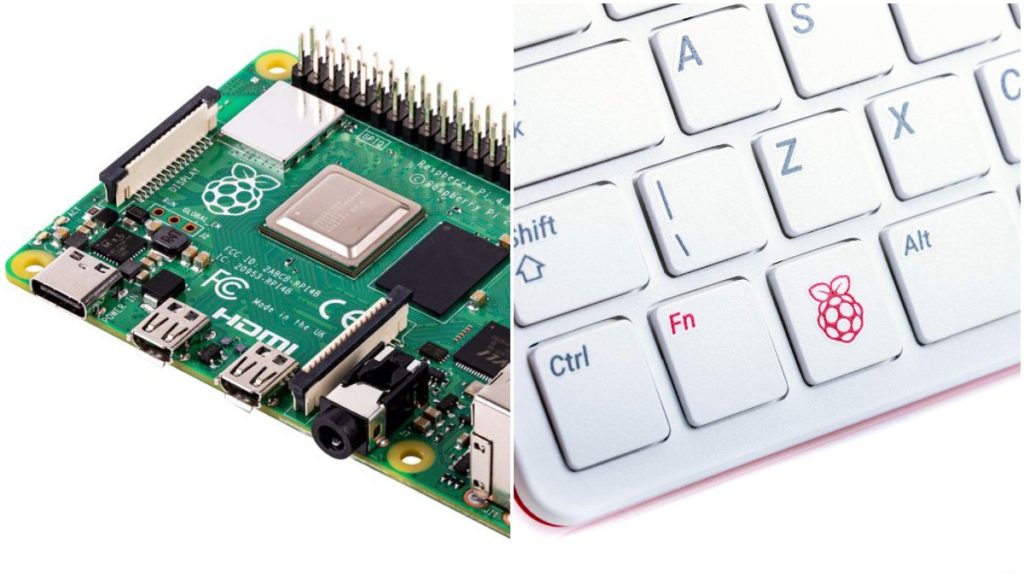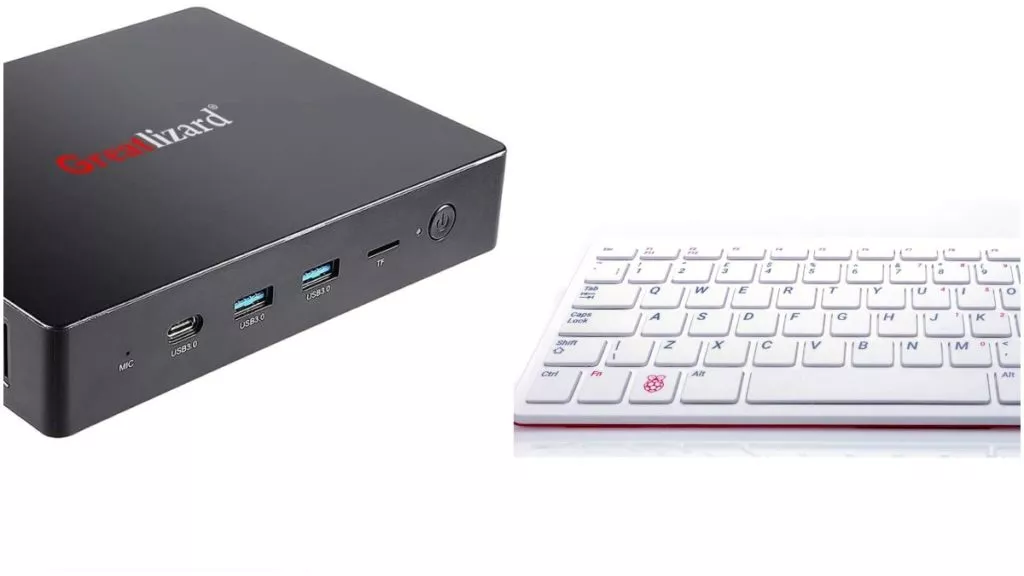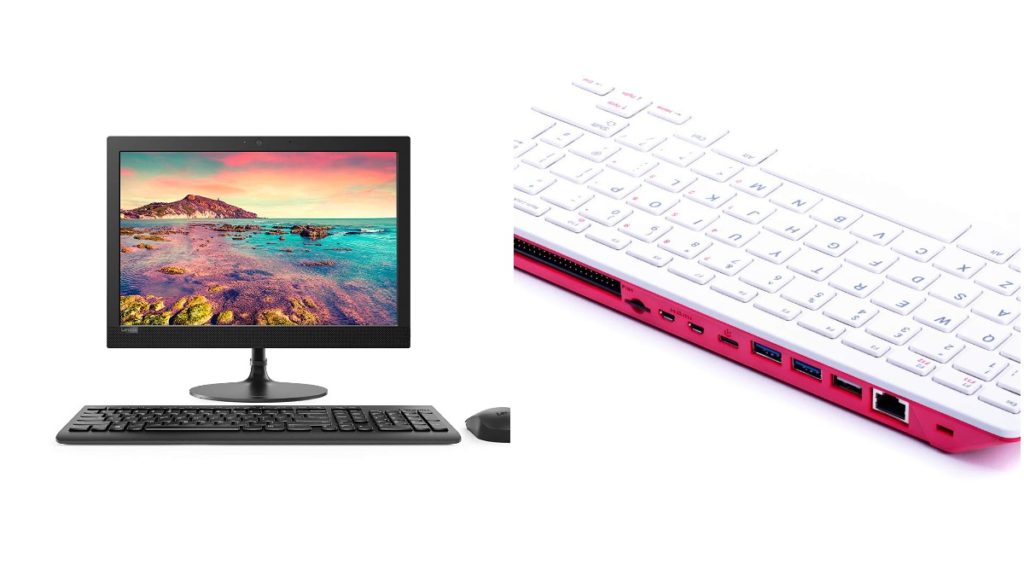Is the Raspberry Pi 400 better than an All-In-One (AIO) PC? Or, more importantly, is it an AIO PC or a mini PC? In this article, we will take a deep dive into the latest Raspberry Pi 400 and compare its specs with an AIO PC and a mini PC. We’ll try to determine how each of them fare based on portability, affordability, value for money, and all the other factors that might influence your buying decision.
First up, we will overview the Raspberry Pi 400, its specs, and all the other features that separate it from the Raspberry Pi 4. Both of these Single Board Computers or SBCs have similar internals. They have the same GPU, CPU, and RAM. But due to their design differences, they have quite different abilities; here’s what you need to know.
Raspberry Pi 400 Vs Raspberry Pi 4: What’s The Difference And Which One Is Better?

Design Differences
I should inform you that the Raspberry Pi 400 is in the shape of a keyboard. It comes bundled inside a keyboard, with all of its Input-Output I/O ports present on the front side. Meanwhile, the Raspberry Pi 4 looks like a traditional SBC. It is rectangular, and all the necessary I/O ports are present on its different sides.
If you open up the Raspberry Pi 400 using a plying tool, since it has no screws, you’ll find a distinctly designed SBC. The Pi 400 features a brand new PCB in the shape of a keyboard, and all the I\O ports are placed on one side of it. You also have a massive heat shield inside the Pi 400 keyboard, which keeps the SBC running as cool as possible.
Meanwhile, you can see the design of the Pi 4 through your naked eyes. Although it does not fit inside a fancy keyboard, you can still choose from hundreds of aftermarket cases and find a suitable casing for the Pi 4.
So, the Pi 400 features a unique design, but that’s for a reason we’ll learn later in the article, and Pi 4 has a conventional SBC design.
Raspberry Pi 400 Vs Raspberry Pi 4: Specs And Performance Compared
Both the Raspberry Pi 400 and the Raspberry Pi 4 use the Broadcom BCM2711 Quad-Core Cortex-A72 processor. But while it is clocked in at 1.8 GHz on the Pi 400, the Quad-core unit is slower on the Pi 4 at 1.5 GHz. And it’s here that distinct PCB design and the massive heat-shield inside the Raspberry Pi 400 keyboard come into play.
The over-clocked nature of the Pi 400 makes it run hot, but due to a larger PCB and heat-shield, it can stay over-clocked at 1.8 GHz all day. Furthermore, a test conducted by the YouTuber ETA Prime over-clocked the already Pi 400 even further, pushing its clock to 2.2 GHz. And the best part is that the device still maintained performance around 55 to 60-degree celsius, which is impressive. The YouTuber even recommended running the Pi 400 at 2.2 GHz all day, as it’s the passive cooling system that was so significant.
Apart from CPU performance, both SBCs have the same 4 GB LPDDR4 RAM, support for 5 GHz Wi-Fi network, and Bluetooth 5.0.
In terms of performance, both the Pi 400 and Pi 4 can do everyday computing tasks very quickly. You can watch up to 720p videos on YouTube on both devices. Moreover, you can edit documents, surf the internet, and perform light image editing on the Pi 400 as well as on the Pi 4.
These devices come with a GPU clocked in at 600 Mhz that can perform emulation gaming smoothly. You can directly play games like Minecraft on the Raspberry Pi 4 and 400, and you can use Dreamcast emulators to play older titles.
Overall, the Raspberry Pi 4 and 400 perform the same when running different applications. However, the Pi 400, with its overclocked CPU, can better handle more CPU intensive tasks like opening multiple internet tabs, streaming videos, and multitasking.
Raspberry Pi 400 Vs Mini-PC: Price, Specs, Performance, Ease of Usage, Portability Compared

We are comparing Raspberry Pi 400 with a mini PC because we cannot strictly consider the Pi 400 as an All-In-One PC. AIO PCs consist of monitors with enough space to encompass all the necessary components required for running a computer. All you need to do to turn ON an AIO PC is to plug it in a power socket. Although AIO does not come with an inbuilt keyboard and a mouse, their prices are mostly included in the price of the PC.
Meanwhile, as I already mentioned, the Raspberry Pi 400 is a keyboard with some of the components required to run it. Its power supply is not internal, and it does not come with a screen either.
But for the sake of the comparison, let’s assume the Raspberry Pi 400 is a Mini PC to see how it fares against an actual one.
Price Comparison
At $100, the Raspberry Pi 400 will always be the most affordable option on the market. Now I had the humongous task of finding the cheapest possible mini PC to compare it with a Pi 400. I found one in the form of Minis Forum Deskmini UM300. The Ryzen 3 Mini PC capable of 4k 60 Hz output had a price tag of $300.
I needed something even more affordable, and I finally found it. At $129, the Greatlizard/Macnano AL1 is probably the best competitor to the Pi 400.
Performance And Specs Comparison
As you can see, the AL1 has the slower LPDDR3 RAM, Intel HD500 graphics, and an Intel J3455 processor, which was announced in 2016. Another main difference between these machines is that the AL1 uses an X86 intel processor, meanwhile Raspberry Pi uses an ARM-based chip. It means that several desktop apps, like Google Chrome, will function on the AL1 but not on the Raspberry Pi 400. You can check the specs of both these machines here.
| Raspberry Pi 400 | Greatlizard/ Macnano AL1 | |
| RAM | 4 GB LPDDR4 | 4 GB DDR3 |
| CPU | Broadcom BCM2711 Quad-Core Cortex-A72 | Intel Celeron J3455 Quad Core |
| I/O | Micro-HDMI, GPIO, USB 3.0, Ethernet port, USB Type-C | VGA, HDMI, LAN, USB 2.0, Micro SD Card slot, USB 3.0 |
| Expandable Storage | Micro SD card slot | Micro SD Card slot |
| Architecture | ARM Raspbian OS | X86 Windows 10 |
In terms of performance, you can expect the Intel processor to have the edge over Broadcom when it comes to video streaming and everyday computing. However, due to its ARM-based design, the Broadcom chip will have a serious advantage over intel in terms of power efficiency.
Ease of Usage
AL1 runs Windows 10, which is a familiar experience for most users. On the other hand, the Raspberry Pi 400 uses Linux-based Raspbian OS, which is similar to a Windows experience. But you won’t find many native applications here, including several games, Google Chrome, and other software.
Portability
Both of these devices lack a screen. Furthermore, the AL1 lacks a mouse and keyboard, something the Raspberry Pi 400 comes with. So in terms of portability, the Pi 400 is easy to carry around with you compared to AL1.
Overall, the Raspberry Pi 400 is more portable, albeit less powerful than a similarly priced AIO PC. But it trumps in terms of price and ease of usage (for some users).
Raspberry Pi 400 Vs All-in-One PC: Price, Specs, Performance, Ease of Usage, Portability Compared

As mentioned, AIO PCs are comprised of a screen that houses all the necessary components inside it. Both Raspberry Pi 400 and an All-in-One PC include custom-designed PCBs and a massive heat shield to prevent overheating. But here’s where the similarities end as AIO PCs differ hugely from a Pi 400 in terms of performance, portability, ease of usage, etc.
Price Comparison
AIO PCs with an integrated monitor are quite expensive when compared with a Raspberry Pi 400. The cheapest one that I could find was Lenovo Ideacentre AIO 330. It had a price tag of $256 and included a mouse, keyboard, and the AIO PC itself.
The price range for the AIO PC goes all the way up to $6,000 with the Apple iMac Pro offering workstation level performance and features.
Performance And Specs
Here’s how the Raspberry Pi 400 compares to the Lenovo AIO 330 in terms of specs.
| Raspberry Pi 400 | Lenovo Ideacentre AIO 330 | |
| RAM | 4 GB LPDDR4 | 4 GB DDR4 (expandable up to 8 GB DDR4) |
| CPU | Broadcom BCM2711 Quad-Core Cortex-A72 | Intel Celeron J4025 Quad Core |
| I/O | Micro-HDMI, GPIO, USB 3.0, Ethernet port, USB Type-C | HDMI output, LAN, USB 2.0, 3-in-1 card reader, USB 3.0, RJ45 Ethernet |
| Expandable Storage | Micro SD card slot | None |
| Architecture | ARM Raspbian OS | X86 Windows 10 |
As we can see, the Lenovo AIO 330 overpowers the Raspberry Pi 400 in almost every way. It features 4 GB DDR4 RAM, which is faster than the LPDDR4 on the Pi 400. Furthermore, it is capable of streaming videos at 1440p resolution, whereas the Pi 400 is restricted to 720p due to the lack of processing power.
The Lenovo AIO also consumes more power than the Raspberry Pi 400 due to a higher boost clock and powerful internals. To conclude, the Lenovo AIO PC easily overpowers the Raspberry Pi 400 in everyday computing tasks and is less efficient than the SBC as well.
Ease of Usage
Since the Lenovo AIO PC uses Windows 10 as well, all the pros and cons of the Mini PC will apply in this case as well. The operational difference between an X86 based PC (Lenovo AIO) and an ARM-based one (Pi 400) remains clear in this case. Native Windows apps have a hard time running on the ARM and vice versa.
People achieve cross-functionality between apps by using emulators, especially if you want to play Windows games on an ARM processor. So, the ease of usage will depend on the type of apps you mostly use. For light computing, both computers will suffice. However, if you wish to run native windows apps, the Lenovo AIO PC is more suitable.
Portability
The Raspberry Pi 400 is easily the more portable option between the two. You can even hook up your Pi 400 with a portable tablet monitor. On the other hand, the Lenovo AIO PC is seemingly less portable with a heavy monitor, which also houses all the necessary components. And while you can keep your Raspberry Pi 400 in a bag along with a power bank and a portable monitor to travel around the world, you can not do so with an AIO PC.
In Conclusion
An AIO PC, a mini PC, and a Pi 400 are all different types of devices made for specific purposes. However, their functionality does overlap in some areas like everyday computing, light image editing, and internet browsing.
As we have seen, the Raspberry Pi 400 scores high points due to its highly affordable prices and highly portable nature and manages to retain enough praise to call itself an everyday usable machine.
In the end, I don’t think under $100, you can get anything better than a Pi 400 for your daily task. I’d recommend it pairing it up with a tablet monitor, and you’ll have yourself a portable PC-like experience every time you sit down to work, play, or just browse the endless pages on the internet.
The post Raspberry Pi 400: Does A PC Inside A Keyboard Make More Sense? appeared first on Fossbytes.
Raspberry Pi 400: Does A PC Inside A Keyboard Make More Sense?
read more
No comments:
Post a Comment